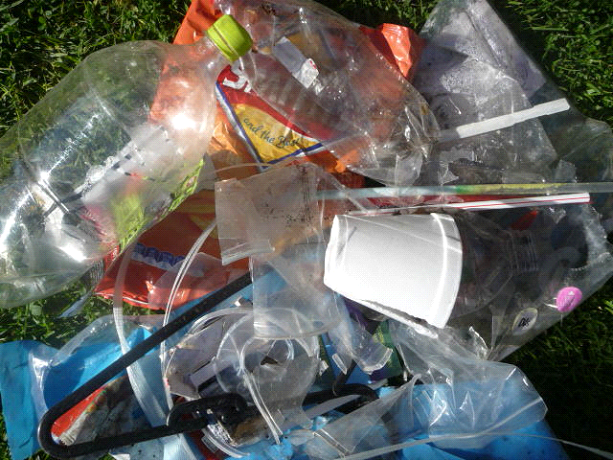A national container deposit scheme the cheapest option for industry | Blogs | Main
Posted on April 4, 2012 by DrRossH in Plastic Limiting RegulationsA national container deposit scheme the cheapest option for industry | Blogs | Main.
This confirms the research by PWS that the cost of the Stewardship schemes considered in this RIS report in Australia were hugely underestimated. The funding estimate came from industry who make the containers and who strongly oppose a container recycling scheme. Therefore there is no surprise they wanted to provide a very low ‘cost’ number versus the cost to introduce a Container deposit scheme. If the politicians buy into this Stewardship or self managed scheme proposed by industry as being the lowest cost for the economy, then we will simply get what we have been getting in the last 20 years. i.e. only 20% or so of bottle recycled by avid recyclers and the rest going to the landfill as lost resources or to be littered along our roads, in parks and on beaches.
The RIS report was done be a large multinational research company so it is surprising they just accepted the ‘cost’ number from industry as the ‘cost’ to do what was proposed. What if that number is ten times higher? Will industry contribute ten times as much or go back to saying the public needs more education and absolve themselves of further responsibility for environmental problems with their bottles and containers as they do now.

 How many people today grab a takeaway coffee cup from the local cafe to drink on the go? We don’t know, but the number must be enormous.. Most every one of the above have a plastic top that will last 100s of years. Some cafes still use plastic cups that last a similar time. Is 10 minutes of coffee worth 100s of years of trash?
These items can be seen littering our gutters and on our streets all over the place. If they were all cardboard, they would still be littered, but they would, at least, be gone in a short time.
They do not need to be made of plastic.
How many people today grab a takeaway coffee cup from the local cafe to drink on the go? We don’t know, but the number must be enormous.. Most every one of the above have a plastic top that will last 100s of years. Some cafes still use plastic cups that last a similar time. Is 10 minutes of coffee worth 100s of years of trash?
These items can be seen littering our gutters and on our streets all over the place. If they were all cardboard, they would still be littered, but they would, at least, be gone in a short time.
They do not need to be made of plastic.
 On the way home from the gym last week, a distance of about 1 km (1/2 mile), I counted the items of plastic litter on the curb as I walked. In that short distance I counted 63 pieces of plastic litter. Plastic drink bottles, bottle tops, candy wrappers, plastic film, polystyrene fragments etc. That seemed to be a lot to me. I guess it is a generational thing. Our parents would have been horrified to see that amount, whereas it seems to go unnoticed by our youth of today. In another 20 years how many pieces will there be on this stretch, -- 200? What will today’s youth think of that new amount then when they are older? Will their children be so readily accepting of a higher amount of litter?
On the way home from the gym last week, a distance of about 1 km (1/2 mile), I counted the items of plastic litter on the curb as I walked. In that short distance I counted 63 pieces of plastic litter. Plastic drink bottles, bottle tops, candy wrappers, plastic film, polystyrene fragments etc. That seemed to be a lot to me. I guess it is a generational thing. Our parents would have been horrified to see that amount, whereas it seems to go unnoticed by our youth of today. In another 20 years how many pieces will there be on this stretch, -- 200? What will today’s youth think of that new amount then when they are older? Will their children be so readily accepting of a higher amount of litter?
Jenny Pickles says:
Post Author April 10, 2012 at 4:08 amI note your comment in relation to the Packaging Impacts Consultation Regulation Impact Statement and costings by PricewaterhouseCoopers (PWC). All opions, including a range of industry options and national container deposit scheme (CDS) options were modelled by PWC, showing the most costly options to be a national CDS to achieve similar outcomes for recycling and litter as other much less costly options. In their report, PWC also noted that the recycling rate in 2009-10 for beverage containers was 48%, not the 20% you quote (unsourced) in your commentary above. Recent research in 2010-11 by respected consultants, Industry Edge, has shown that beverage container recycling rates have since increased to 52%. The Industry Edge report can be downloaded at: http://www.afgc.org.au/doc-library/category/9-packaging-recycling.html?download=683%3Aindustryedge-beverage-container-and-aluminium-aerosols-data.
I’d encourage you to have a look at some of the successful projects industry is actively putting in place across Australia to increase beverage container recycling rates and make it just as easy to recycle away from home as it is as home. See: http://www.afgc.org.au/psf
DrRossH says:
Post Author April 10, 2012 at 7:58 amThank you for the comment. My numbers were referring only to plastic containers (as this is a plastic waste website). The recycling plastic bottles is much lower than the general number. 35% nationally and 27% for a State like Victoria. At home recycling is much higher as there the problem is taken care of by kerb side collections by local councils. Little to do with industry. The away from home where kerb side is not offered has very low recycling rates and that is where industry could have a big impact, but they don’t. We note too that there is a debate going on as to whether the APC numbers are overly optimistic and the container recycle number is 38% not the 49% mentioned above. Apparently there is a problem with their data.
Plus if you just go out and have a look around the streets and walk through some industrial areas the evidence is quite clear, there are littered plastic bottles every few meters in some places to every 100 m or so in others. Until an incentive is put on them for the public to pick them up and get a refund, this is very unlikely to change. For years industry has been saying we are the best to address this issue, but here we are in 2012 and litter of plastic bottles is worse. Recycling rates may be going up but only in small fractions and that is due to the public’s growing environmental awareness, not by industry for the most part. If industry wanted to do something about this they could, but to date we have seen very little which shows us their lack of enthusiasm to take on this issue. It will be expensive compared to what is being done now which is very little. Hence no matter how it is done it is going to cost time and money.
The RIS report in our view took a number that was supplied by industry as to what industry said it would take to get over 80% container recycling. $20m. Then they looked at the costs to set up a CDS this was a large one off number to put the infrastructure in place. The questions has to be asked as to the costs to who? If private recyclers want to start up business to operate the CDS, then there is no cost to the industry bottlers, the public or the government. The private recyclers will do it for a profit which comes from the voluntarily unredeemed deposits.
The largest cost of any recycle/anti litter project is to get the bottles back from the very widely dispersed public hands. Once the containers are in recycle centres then the costs are a lot less and bulk transport efficiencies take over. With a CDS, the public will do all this collection from the widely dispersed public for free! That is very efficient. A stewardship scheme will never compete with that.
We looked at some costs published in WME magazines over the last few months about different states spending funds to set up some type of program in their own states. When these costs were extrapolated to national costs they all came out to be about $300m. This actually makes the PWC BCR less than 1.0 or a real drain on the economy. That is far greater than what industry is telling PWC about what they thought it was going to cost. To us then, there is a real problem here with what industry is saying and what will actually happen. it sounds like a ‘Trust us’ plan just like the last 10 years where industry have failed to deliver real gains.
With the Stewardship model;
1) who would enforce those penalties for not reaching the promised goals?
2) who would decide when it was time to pose the penalty?
3) who would decide a penalty payment was too late in being made?
4) What would late penalties be?
5) The recent dispute in the 320,000 tonnes of container that the Packaging covenant claims
were recycled yet the Boomerang Alliance disputed based on actual reported recycling
tonnages is an example of where things will go wrong. With no one policing these actions,
there is little to believe the claims.
6) If the goals were not met with the $20m what happens then?
7) Who decides how the $20 m is spent? Industry themselves it reads in the RIS.
8) Who decides what constitutes a valid expenditure for this project and what is just working in the interest of the company and given a green brushing? For example, light‐weight of
bottles with a thinner wall. It is claimed this is environmentally beneficial by the bottle
companies as this uses less plastic. Technically true, but light‐weighting of bottles is not
addressing the environmental impact of that packaging, only the manufacturers costs. A
thin walled plastic bottle littering on the ground is still a plastic bottle littering on the
ground. It takes up as much volume in a landfill as a conventional bottle.
9) As stated in the RIS, The National Waste Policy: Less Waste, More Resources was agreed by all Australian environment ministers in the Environment Protection and Heritage Council
(EPHC) in November 2009 and endorsed by the Council of Australian Governments (COAG) in October 2010. “The National Waste Policy sets the direction for national action on waste and resource recovery for the period to 2020. Strategy 3 of the National Waste Policy states: The Australian Government, in collaboration with state and territory governments, industry and the community will better manage packaging to improve the use of resources, reduce the environmental impacts of packaging design, enhance away‐from‐home recycling and reduce litter”. We can hardly call the achievements this policy has brought about so far as successful.
On the other hand;
The benefits to a CDS are many. When a Victorian model is applied to the PWC numbers a CDS has a larger income and a BCR greater than 1.0 arises, or a benefit to the economy. (These just shows how easily the numerbs can be manipulated to achieve a desired outcome).
1) Large reduction in litter (containers only) which is a plus for the citizens to again enjoy their open spaces and for tourist dollars from tourists who would go away thinking Australia was a low litter place. My observations
show we have a few bottles every 100 m on busy streets and parks. That is a lot over a big city let along a nation
2) Large reduction in the larger volume components of litter, namely bottles and similar cartons.
3) Large increase in recycling rates over current rates and associated recovery of resources that would otherwise have to come from new or imported resources. This is a plus for the Australia economy.
4) Create many jobs to support the infrastructure of the CDS, a plus for the local economy
5) Allows people the satisfaction of recycling their containers which is not a time cost but an emotional benefit.
6) Uses the mass public to recovery the containers at zero cost. This is a very large saving as opposed to Options 2 and 3. (As shown in the RSIS report table Cost Benefits). Getting the packaging from out of the widely dispersed public’s hands back to a central recycling point is a very large task and a CDS does this very efficiently.
Fernando says:
Post Author June 22, 2012 at 2:10 pmall glass should be eiethr used in concrete or asphalt or sent off to be remade into glass for reuse that simple land fills are never an answer to glass metel or cardboard ever!!!